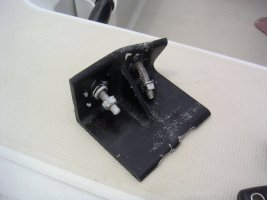Akavishon
Member III
Last Sunday, we got slapped around pretty hard by gusty winds, right after sunset ... I later read on sailnet that a couple of boats nearby (Salem) were knocked down by sudden 35+ kt gusts, so I guess we did alright even if it looked hairy at times.
However, today I noticed that one of my quadrant stops got badly bent and ripped out from the cockpit floor - the bolt heads were neatly countersunk and bedded with caulk, and have been bent and completely pulled through the cockpit floor. I can only imagine that one of my inexperienced crew at the helm reached the limit of the wheel turn but continued to push hard, until the quadrant stop (well, cockpit floor, actually) gave way.
Admittedly, the cockpit floor is (or has been) wet and probably weak, and whoever installed the steering system did not care to create epoxy plugs for the through-bolts.
I have been googling around but can't find a replacement for the mangled quadrant stops - does anyone have any pointers?
TIA - Zoran
However, today I noticed that one of my quadrant stops got badly bent and ripped out from the cockpit floor - the bolt heads were neatly countersunk and bedded with caulk, and have been bent and completely pulled through the cockpit floor. I can only imagine that one of my inexperienced crew at the helm reached the limit of the wheel turn but continued to push hard, until the quadrant stop (well, cockpit floor, actually) gave way.
Admittedly, the cockpit floor is (or has been) wet and probably weak, and whoever installed the steering system did not care to create epoxy plugs for the through-bolts.
I have been googling around but can't find a replacement for the mangled quadrant stops - does anyone have any pointers?
TIA - Zoran


 ("the skipper is responsible for anything that happens on the boat")
("the skipper is responsible for anything that happens on the boat")